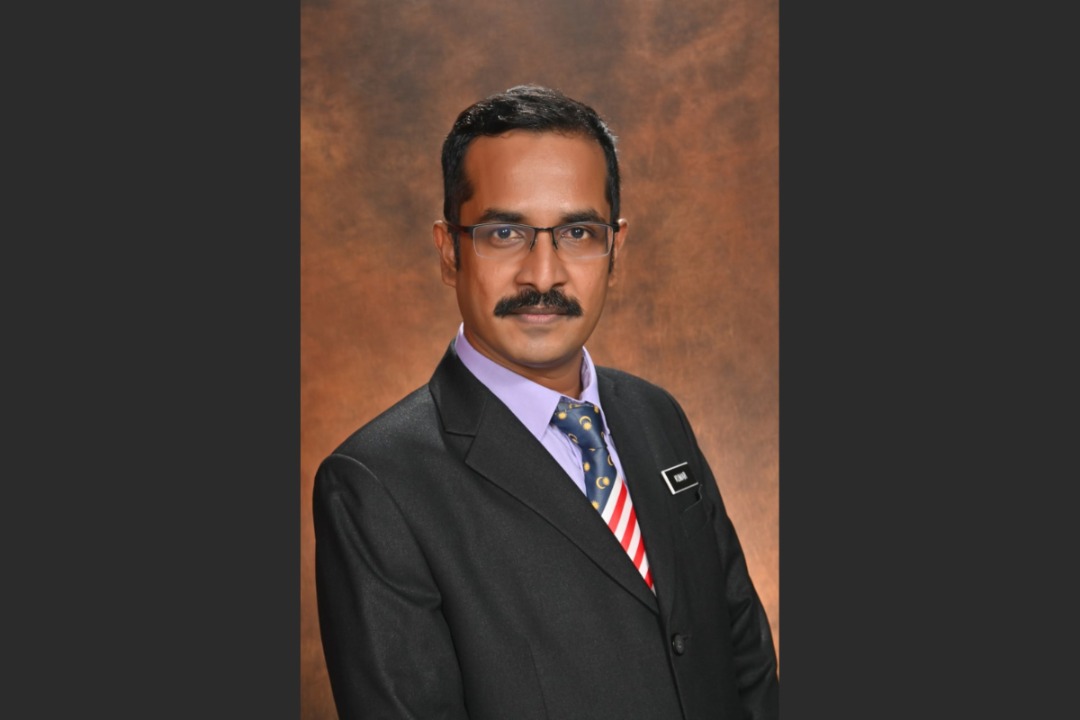KUALA LUMPUR, June 22 – A doctor from Raja Permaisuri Bainun Hospital (HRPB) has accused the Ipoh general hospital’s ambulance service of allowing his brother to die from a heart attack by failing to perform cardiopulmonary resuscitation (CPR).
Despite arriving on the scene within 10 to 15 minutes from an emergency call last April 13, HRPB’s paramedic team did not even remove Dr Thiru Terpari @ Thirupathy’s brother, Kumaraveloo, from the latter’s vehicle, where Kumaraveloo collapsed, to try to revive the 43-year-old man with CPR or by using an available AED device (a machine that delivers a jolt of electricity to get the heart beating again) from the ambulance. This was based on an internal document, an eyewitness account, and police photographs from the scene.
Kumaraveloo, a government school teacher at SMK St Michael in Ipoh, Perak, clocked out from work at about 5.40pm on April 13 this year and was driving alone through Jalan Sultan Nazrin Shah in the capital city when he suffered breathing difficulties and collapsed near the BHP petrol station.
This caused his car to collide into the car in front of him during a bad traffic jam, when vehicles were nearly bumper to bumper.
The driver of the car that Kumaraveloo bumped into – a 30-year-old Ipoh resident named Raymond Loh – then got out of his vehicle. The collision occurred at approximately 6.20pm, according to Loh’s police report on the incident, though Loh told CodeBlue later that the minor traffic accident happened at about 6.10pm.
Loh asked a lorry driver directly behind Kumaraveloo’s vehicle for help to check on Kumaraveloo. Both bystanders were able to open Kumaraveloo’s car door as it was unlocked.
“He was not conscious. The lorry driver was trying to get his attention; there was some movement, like it was very hard to breathe,” Loh told CodeBlue when contacted for his eyewitness account.
Loh said he called 999 and informed the emergency line about Kumaraveloo having breathing difficulties. The 999 operator did not instruct Loh how to perform CPR on Kumaraveloo while awaiting the arrival of the ambulance.
When an ambulance from HRPB arrived approximately 10 to 15 minutes later, Loh said there were only two members of the first responders’ team from the public hospital, comprising the ambulance driver and another person that Loh described as, “I don’t think he’s a doctor because he didn’t do CPR”.
Loh said the paramedic team did not remove Kumaraveloo from his vehicle to place him flat on his back on a stretcher, but simply attached “wires” – monitor leads from an automated external defibrillator (AED) device to check cardiac activity – onto the 43-year-old man’s chest while he was still slumped in his seat.
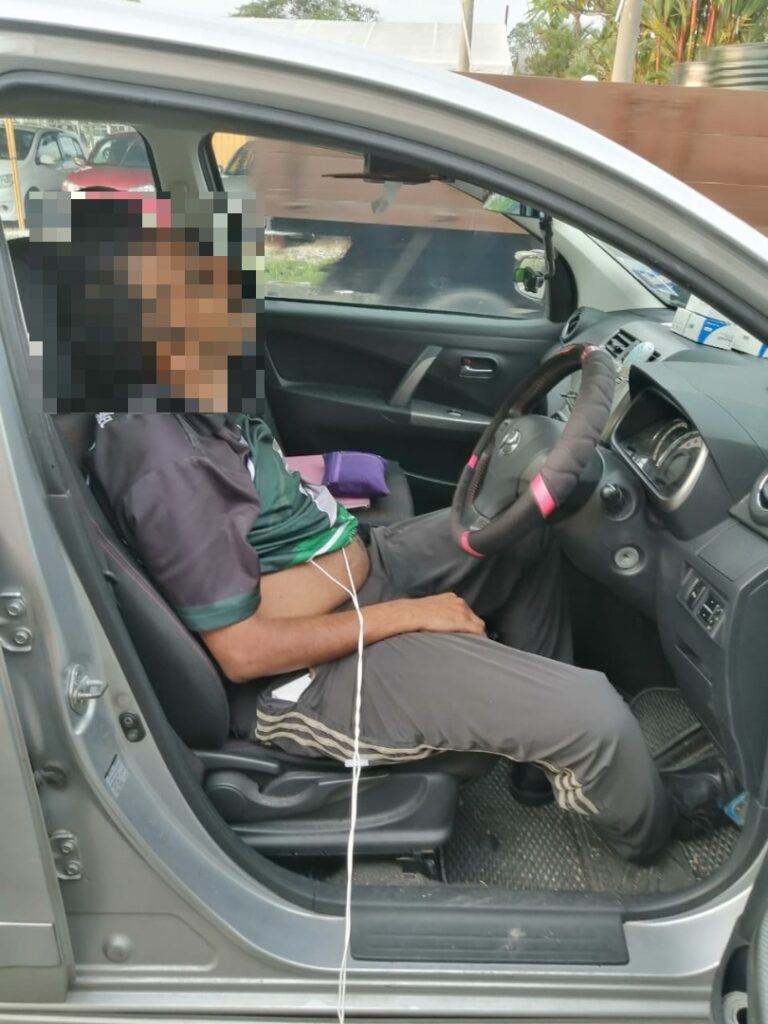
AEDs are portable, lifesaving devices designed to treat sudden cardiac arrest, a medical condition in which one’s heart suddenly and unexpectedly stops beating. According to the United States’ Food and Drug Administration, the combination of CPR and early defibrillation, where an electrical shock is delivered from an AED to jolt the heart back to a regular rhythm, is effective in saving lives when used quickly following collapse from sudden cardiac arrest.
AEDs are simple enough to be used by the general public during emergencies while waiting for the arrival of first responders. Health Minister Khairy Jamaluddin even announced last March that the installation of AEDs would be made mandatory in public areas by 2025.
Yet, in Kumaraveloo’s case, the eyewitness noted that the HRPB paramedic did not perform CPR, a basic lifesaving technique that is taught even to children, or use the AED device to attempt to revive Kumaraveloo.
A photograph of the scene sighted by CodeBlue shows Kumaraveloo still seated in his car with cardiac leads attached to his chest underneath his shirt. An educational video by St John Ambulance in the UK on how to use an AED shows the device being used on a mannequin in the supine position in tandem with CPR, where chest compressions are paused when preparing to shock the patient after clothing is removed from the chest to attach the pads from the device.
Loh said the paramedic told him that Kumaraveloo was “already gone”.
“He said, ‘normally like this, it’s a heart attack’. Then he went to check his car – got any heart attack medicine or anything? The car didn’t have any heart attack medicine, only diabetes. After that, he said ‘passed away’ and he called the police. They waited for the police to come, and then they went off.”

A second eyewitness named Lawrence, who arrived at the scene when the ambulance was already there, said the paramedic showed him the AED device that displayed a flatline, indicating there was no heartbeat.
“He said, ‘he’s no more, heart attack most probably’,” Lawrence, who was Kumaraveloo’s colleague, told CodeBlue. “I said, ‘are you going to take him to hospital?’ They said, ‘no, must wait for the police’.”
A photograph sighted by CodeBlue shows police officers removing Kumaraveloo’s body from inside the driver’s side of the car later that evening after 7pm, with a body bag on the side, before they took him to the mortuary at HRPB.
This confirms the first eyewitness account that the HRPB paramedic never removed Kumaraveloo from his vehicle to try to resuscitate him with CPR and the AED device – as this would not be possible in an upright position in a confined space – until the police picked up the patient’s body from the car.
According to the Department of Statistics Malaysia’s November 2021 report, ischaemic heart disease remained the main cause of death in Malaysia, comprising 17 per cent of 109,155 medically certified deaths in 2020.
Paramedic’s Report States CPR Not Performed, Claims Algor Mortis
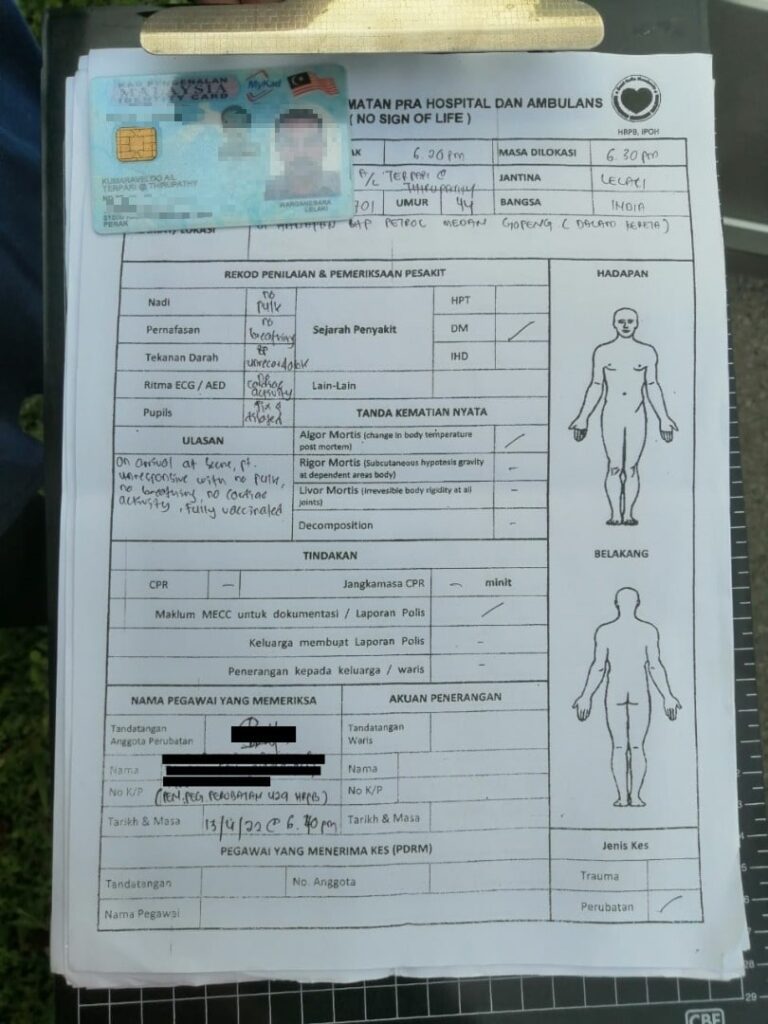
The paramedic – whose name CodeBlue is withholding – is a 28-year-old assistant medical officer U29, also known as a medical assistant, from HRPB, a Ministry of Health (MOH) facility.
A crucial internal document by the medical assistant himself confirms that he did not perform CPR in his emergency response for Kumaraveloo, who died just eight days short of his 44th birthday.
The HRPB medical assistant claimed in the “Laporan Perkhidmatan Pra Hospital Dan Ambulans (No Sign of Life)” that he signed on April 13, 2022, at 6.40pm, as sighted by CodeBlue, that algor mortis – a stage of death when a human’s body temperature drops to the external temperature – had set in, indicating a “clear sign of death”.
Assuming that Kumaraveloo collapsed at around 6.10pm – the approximate time of the collision stated by Loh when Kumaraveloo was reportedly still breathing – this means the paramedic pronounced Kumaraveloo’s death in just 30 minutes at 6.40pm and even claimed the body had turned cold within that short period of time.
The HRPB medical assistant stated in his report that he arrived at the scene at 6.30pm after departing from the public hospital at 6.20pm. CodeBlue understands that 999 diverted the emergency call to HRPB’s Medical Emergency Coordinating Centre (MECC) at 6.17pm.
HRPB’s emergency response time of 10 minutes falls within MOH’s target of less than 15 minutes for critical cases. The Auditor-General’s 2018 Report found that public hospital ambulances in the Klang Valley took up to 87 minutes to reach the incident site in critical emergencies.
Kumaraveloo’s older brother Dr Thiru, 46, was able to obtain the paramedic’s report from a police officer who was a family friend. This internal document is not made available to the patient’s next-of-kin, as it is only given by the first responder to the hospital and to the police. Dr Thiru also said he obtained photographs of the scene from the same police officer.
The HRPB paramedic’s Pre-Hospital and Ambulance Service (No Sign of Life) report also states that Kumaraveloo showed no pulse, no breathing, and no cardiac activity, with his pupils fixed and dilated, while his blood pressure was unrecordable. On underlying disease, only diabetes mellitus (DM) was marked.
Dr Thiru, who works in the medical department at HRPB and is a training specialist in internal medicine, said algor mortis only begins two hours at the earliest after the heartbeat stops, and is established at around 18 hours after death.
“If the paramedic did CPR for half an hour, but still couldn’t revive, I can still accept this. But my brother was left to die in his car, he wasn’t even brought to the ambulance,” said Dr Thiru, who travelled from Ipoh to speak to CodeBlue here last Saturday.
When contacted, the HRPB medical assistant declined to comment on Kumaraveloo’s case, telling CodeBlue that he was not authorised to speak to the press.
Post-Mortem Report, Death Cert Use Paramedic Report’s Signature Time As Official Time Of Death

A post-mortem report on an autopsy performed on Kumaraveloo’s body at HRPB in the morning of April 14, as sighted by CodeBlue, concluded “coronary artery disease with myocardial fibrosis” as the main cause of death, categorised as “subjective” pending the outcome of toxicological results.
The same cause of death was listed in Kumaraveloo’s death certificate that was sighted by CodeBlue.
Coronary artery disease, or ischaemic heart disease, is a common heart condition.
Both the post-mortem report and death certificate state the date and time of Kumaraveloo’s death as April 13, 2022, at 6.40pm – the same date and time when the HRPB medical assistant signed his Pre-Hospital and Ambulance Service (No Sign of Life) report that claimed algor mortis, one of the “Tanda Kematian Nyata” (Clear Sign of Death) categories in the document.
This raises questions as to whether a medical assistant – as opposed to a doctor or a registered medical practitioner – is authorised to officially pronounce a person’s death unilaterally.
HRPB’s Response: Victim Showed ‘No Sign Of Life’
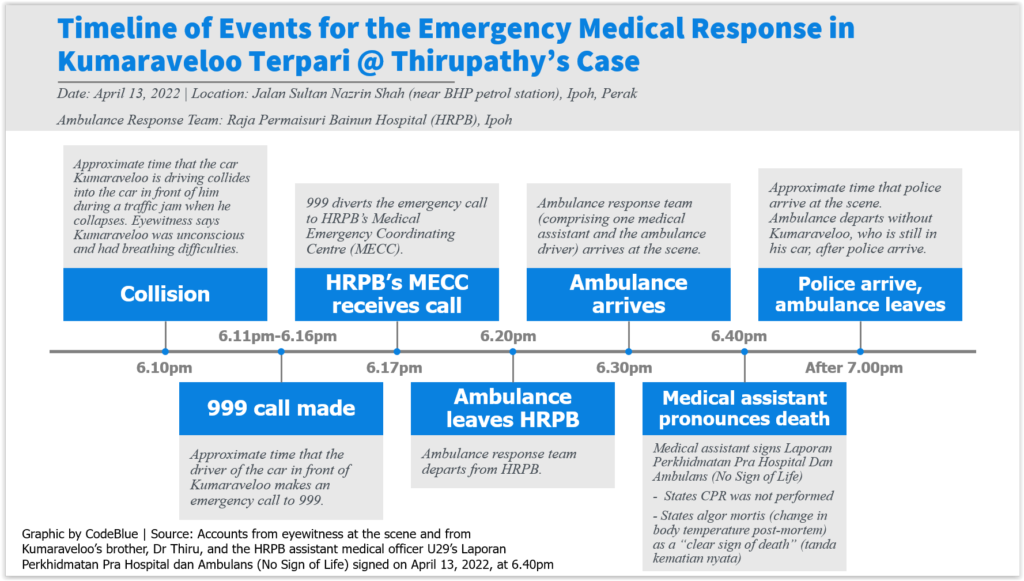
HRPB director Dr Megat Iskandar Megat Abdul Hamid said in a brief statement in reply to CodeBlue’s queries that his facility is currently investigating the first response in Kumaraveloo’s case, including the entire chain of events from the time the emergency call was received to the time the ambulance response team (PRA) left the scene of the incident.
“Upon arrival at the location, the HRPB PRA conducted an evaluation and examination of the victim and found that the victim showed no sign of life,” Dr Megat Iskandar told CodeBlue Monday.
“HRPB sympathises and expresses condolences to family members of the deceased.”
HRPB did not specify what exactly the paramedic did in the 10 minutes between arrival at the scene at 6.30pm and pronouncing Kumaraveloo dead at 6.40pm.
MOH Policy Requires Resuscitation In Cases Showing No Sign Of Life
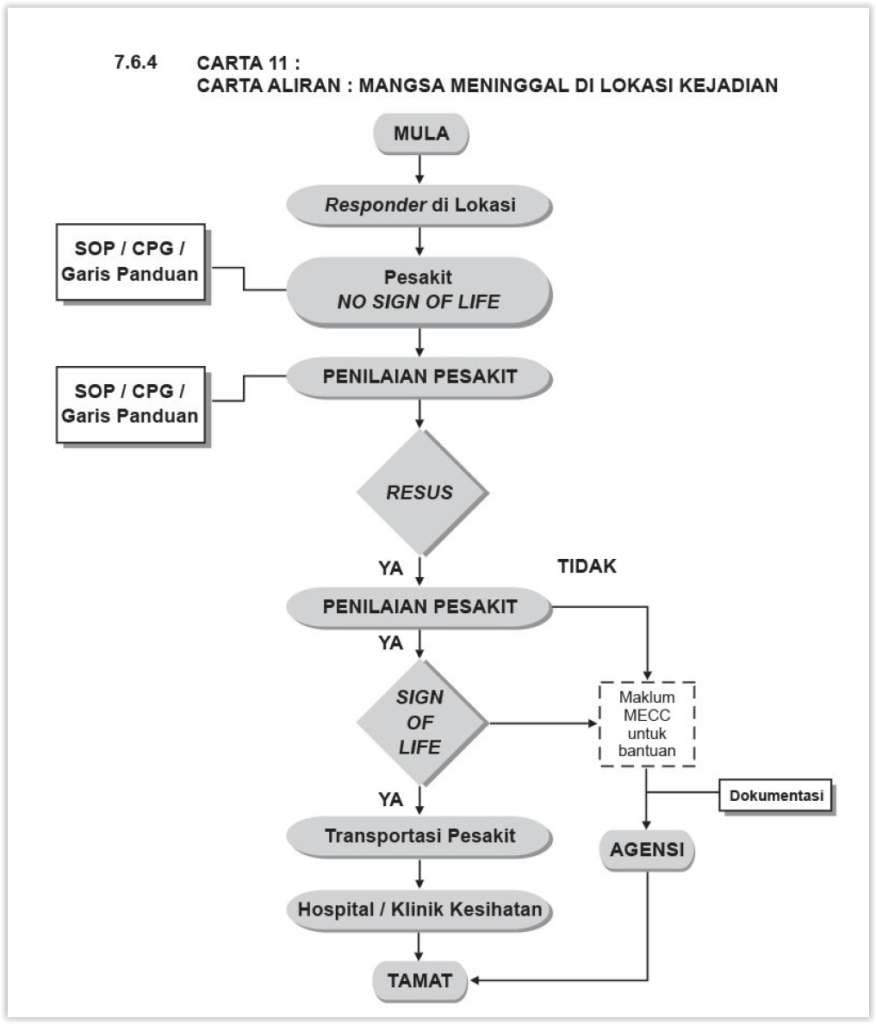
According to the Selangor state health department’s “Guidelines and Policy: Pre-Hospital and Ambulance Treatment Service”, resuscitation is mandated in emergency cases that show “no sign of life”.
If the patient still shows no signs of life after resuscitation efforts, the first responder is required to call the 24-hour MECC – one of the Emergency and Trauma Department components that manages 999 emergency calls – for assistance or medical directions. The definition of cases with no sign of life includes “post-resuscitation – irreversible” and algor mortis.
MOH’s “Emergency Medicine and Trauma Services Policy” mandates “constant communication” between the ambulance and its respective MECC, including requiring the ambulance team to provide information on victim assessment and outcome of care provided at the scene.
The ambulance team must also request online medical direction from the MECC in certain “extreme” or “unique” emergency situations.
Dr Thiru alleged that the HRPB paramedic did not call the hospital’s MECC for further instructions during the emergency medical response in his brother’s case. HRPB’s MECC head declined to comment when contacted by CodeBlue, as she was not authorised to speak to the press.
According to the “Recommendations on the Minimum Standards Required for the Management of Adult Out of Hospital Cardiac Arrest in Prehospital Care Services” by the College of Emergency Physicians, Academy of Medicine Malaysia, CPR on adults with out of hospital cardiac arrest (OHCA) at the scene – who are unconscious and have not been breathing for more than 10 seconds (apnoeic) or have abnormal breathing – must be initiated “without delay” when indicated.
All CPR must be performed with the OHCA victim lying supine on the ground or floor.
CPR interventions can only be withheld from OHCA victims with signs of “clinical irreversible death”, comprising rigor mortis (body stiffens after a few hours from death); dependent lividity (bluish-purple discolouration of skin after death); fatal injuries like decapitation, transection (cutting across, typically a tubular organ), or incineration (more than 95 per cent full thickness burns); or decomposition.
Medical Assistant Didn’t Perform CPR, Claimed Algor Mortis In Second Case
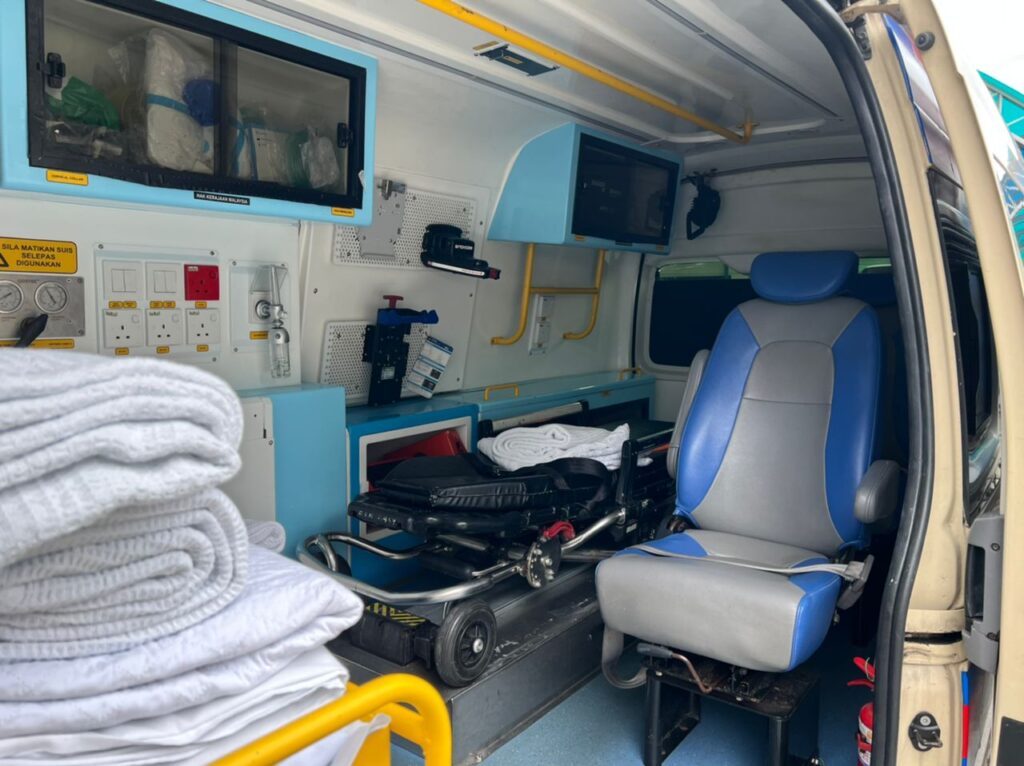
The HRPB medical assistant who attended to Kumaraveloo similarly claimed algor mortis in a second emergency case that he handled last May 11 and did not perform CPR on the patient – an 85-year-old male motorcyclist on the roadside in front of OYO Hotel at Jalan Kuala Kangsar, Batu 9, Chemor, following an accident.
The purported algor mortis finding and lack of CPR intervention were documented in the Pre-Hospital and Ambulance Service (No Sign of Life) report, as sighted by CodeBlue, that the medical assistant signed at 1.16pm, just 11 minutes after his stated arrival at the scene at 1.05pm. He departed from HRPB 15 minutes earlier at 12.50pm, according to the document.
In his written assessment, he remarked that on arrival, the patient was unresponsive with no pulse, no breathing, and no chest rise. No cardiac activity was found either, while pupils were fixed and dilated. Blood pressure was unrecordable. The medical assistant did not mention any serious traumatic injuries in his report.
His May 11, 2022 report also stated that he did not contact the MECC for documentation or filed a police report. The patient’s family, he said, had filed a police report and an explanation was given to the family or next-of-kin.
Dr Amy (pseudonym), a medical officer at HRPB who happened to pass by the scene with two of her doctor co-workers after the ambulance arrived, said other bystanders told her that the motorcyclist was still alive and gasping when they saw him prior to the arrival of first responders.
She said that the medical assistant from the HRPB ambulance response team, which only comprised him and the driver, merely attached an ECG machine to the patient that appeared to show the absence of a pulse.
When she questioned the paramedic on why he didn’t perform CPR on the patient, she said he told her that it was “too late” because it took him 20 minutes to arrive at the scene from the hospital. His purported verbal remarks to Dr Amy contradict his written report that he arrived in 15 minutes.
“‘Memang tak akan buat sebab sudah terlambat’ (we won’t do it because it’s too late),” she quoted the medical assistant as saying.
Dr Amy told CodeBlue yesterday that she observed an exposed wound on the motorcyclist’s leg as the only obvious physical injury, without any bleeding or bruises all over the body. The man died.
She pointed out that in such cases where a collapse is seen by others, called “witnessed collapse”, medical professionals would perform CPR immediately even if the patient did not show a pulse.
“If there is a ‘witnessed collapse’ near the hospital, there should be CPR because of cardiac arrhythmia (irregular heartbeat). That’s one of the protocols.”
When asked why she and her two physician colleagues among the small crowd did not intervene and perform CPR, Dr Amy said: “I couldn’t do anything. There were only seven of us; only me wanting to do, it’s impossible.”
The doctor called for proper management of patients who collapse at roadsides, pointing out that when she was a house officer in Penang, she used to follow along on ambulance calls and attended to patients.
“But in this scenario, only the MA (medical assistant) attended and no proper management was given, none of the superiors were there to monitor as well.”
Faded Responder Bag’s Medication Labels
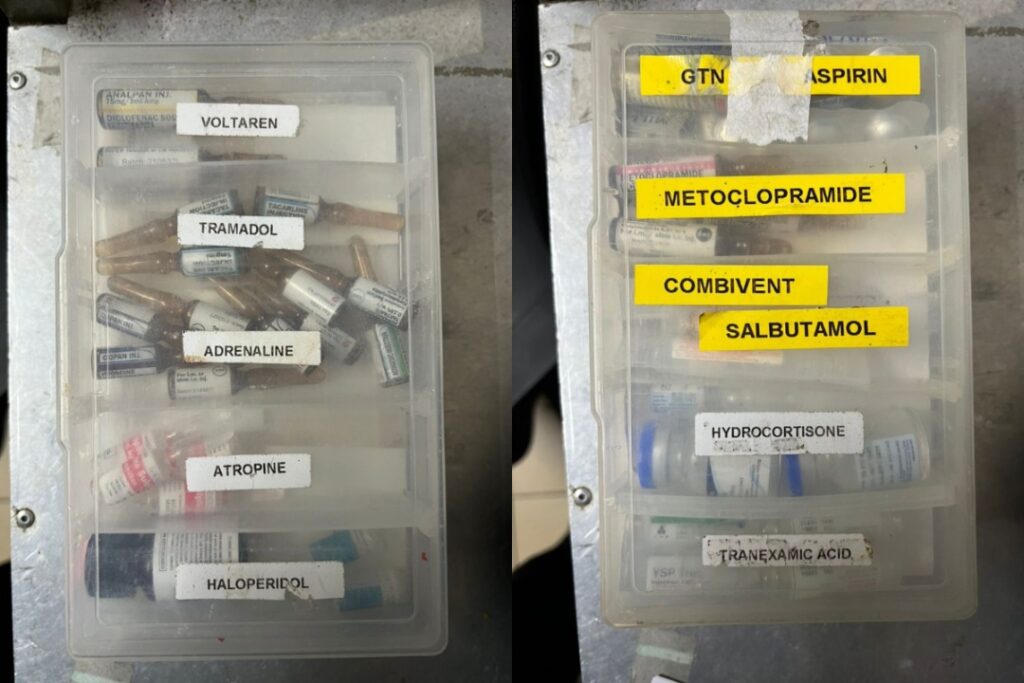
An ISO: 9001 audit report by the ISO team in HRPB’s ambulance service dated December 17, 2021, as sighted by CodeBlue, revealed that the labels of medications in the responders’ bag, which includes resuscitation drugs, had faded. The labels on GTN tablets, which are used to treat angina (chest pain), had also gone dull.
The government hospital stated in the report that remedial actions have been taken and continuous monitoring undertaken.
“It happened because the paramedics don’t use the resus medications till the labels are gone also, they are not bothered,” Dr Thiru claimed.
He alleged that a paramedic from HRPB (not the one who attended to his brother) told him that they could not remember when was the last time their team performed CPR on an emergency call.
“A paramedic told me, ‘Doctor, you need to understand the situation. They’re alone, one person, plus the driver. So what is easier for them to do?’
“‘If want to intubate and all these things, it’s very hard work, it’s very difficult for a single person to do all these things. So sometimes, they choose what is easier for them to do, which is to let the person go’,” Dr Thiru said, quoting the paramedic.
Police To Summon Witnesses, Refer To Prosecutor And Coroner
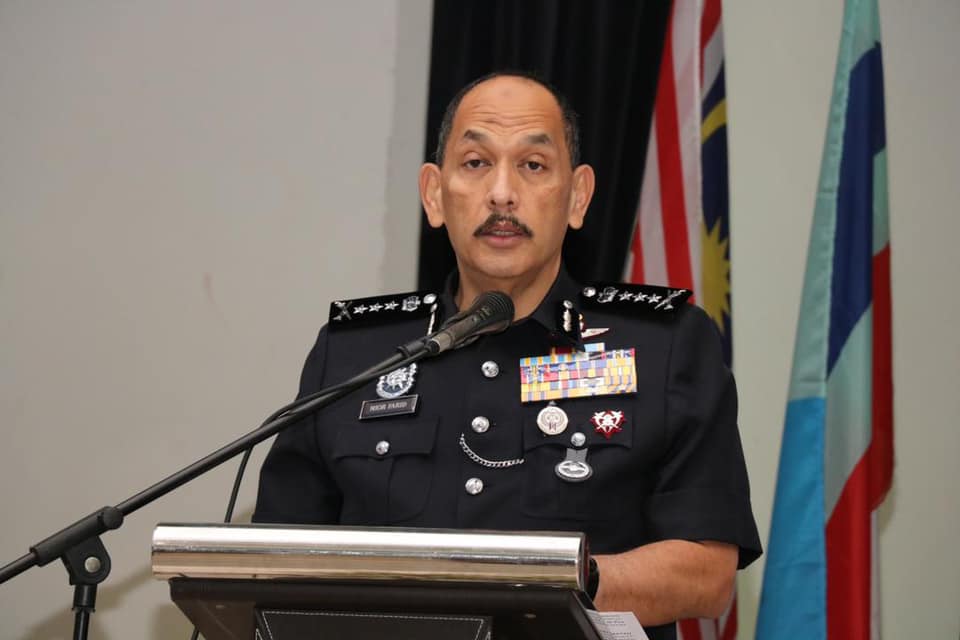
Perak police chief Mior Faridalathrash Wahid said the police investigation on Dr Thiru’s complaint about the emergency medical response in his brother’s case is currently classified as sudden death.
“We will call up and interview all the witnesses involved. After this SDR (sudden death report) investigation is complete, we will refer to the deputy public prosecutor before referring it to the coroner, in accordance with the provisions of the law,” Mior told CodeBlue when contacted.
Dr Thiru filed his first police report last April 26 against both the paramedic and the unit head of MECC at HRPB, accusing the former of failing to perform CPR, with the excuse that Kumaraveloo’s body had gone cold, and to properly check Kumaraveloo’s condition before pronouncing the man’s death.
“The said paramedic’s negligence and hasty and irresponsible actions at the critical moment caused my brother’s death,” read Dr Thiru’s police complaint, as sighted by CodeBlue.
Dr Thiru questioned why supervisors of the paramedic who attended to his brother did not immediately raise concerns about the latter’s report claiming algor mortis signs on Kumaraveloo.
“If someone checks this documentation, this is fake documentation,” Dr Thiru alleged. “They should have picked up this thing on that particular day. No issue at all until I made a complaint. It shows that senior paramedics are sleeping on the job or they don’t care about it.”
He has also filed a complaint to MOH.
Kumaraveloo Was A Dedicated Teacher, Received Anugerah Perkhidmatan Cemerlang
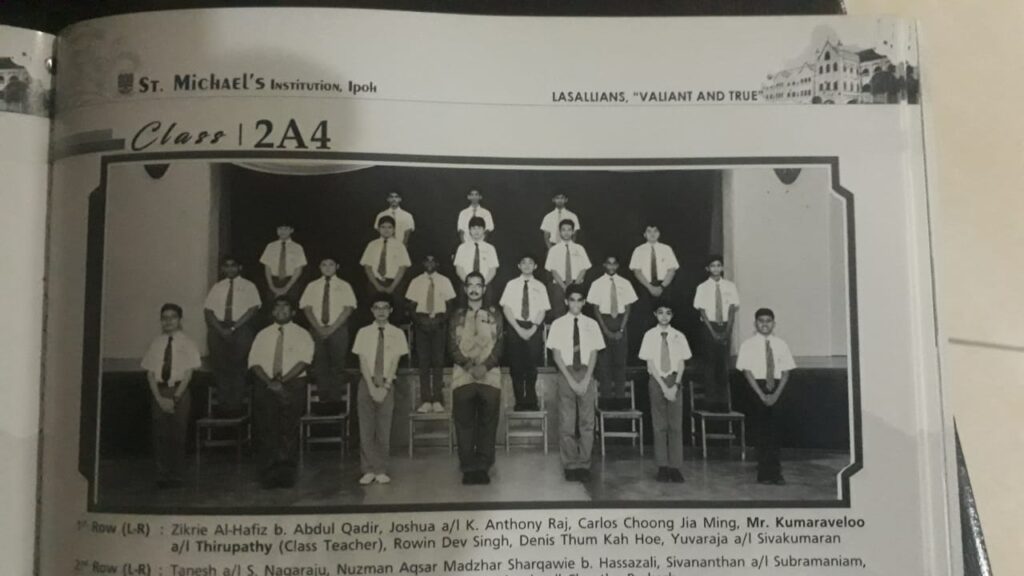
Kumaraveloo was an IT and mathematics school teacher at St Michael’s, a LaSallian institution in the Perak state capital of Ipoh.
He joined the service under the Education Ministry in 2007. His first posting was in SMK Sri Aman in Sarawak, before transferring back to Perak in 2015 and serving SMK Simpang Pulai. He was transferred to SMK St Michael in November 2019.
Dr Thiru said his late brother just obtained his master’s in IT with education from Universiti Pendidikan Sultan Idris (UPSI) last November, and was supposed to attend convocation last June 11. Kumaraveloo also had plans to pursue a PhD.
Kumaraveloo’s co-worker Lawrence – who went to the scene of Kumaraveloo’s collapse after a bystander (the lorry driver behind Kumaraveloo’s car) called him using Kumaraveloo’s phone – described his colleague as a friendly and very helpful man.
He said Kumaraveloo had received the Anugerah Perkhidmatan Cemerlang (APC) from the Public Service Department for 2021, an award for excellence in service that was also given to only one other teacher at the secondary school.
“It was given out last Thursday at a staff meeting. We observed a minute’s silence. He was one of the dedicated teachers,” said Lawrence.
Lawrence, who declined to provide his full name, told CodeBlue that Kumaraveloo was a reference point for teachers in their school to solve IT issues.
He said Kumaraveloo was elected president of the school’s staff club, which organises events like annual dinners for staff, for two to three years running because “he was doing such a good job”.
“Before his death, he said ‘no more, ask somebody else to take over’,” Lawrence said. “Until now, we’re feeling the loss of Kumaraveloo.”
Awaiting Criminal Investigation, No Plans For Lawsuit

The passing of Kumaraveloo, who was not married, left behind his mother, whom he was living with in Ipoh, seven siblings, as well as his father who is living in Petaling Jaya, Selangor. Dr Thiru is now taking care of his late brother’s 10 lovebirds.
“Feeding the birds reminds me of him.”
When asked if he planned to sue the government, the physician said he had no plans for civil litigation because the money wouldn’t bring his brother back.
“I’m waiting for the police to decide whether there’s a criminal case,” said Dr Thiru. “I don’t want the same thing that happened to my brother to happen to another person.”
By all accounts, Kumaraveloo had nearly everything in his favour to potentially survive a heart attack: the ambulance came on time; he didn’t suffer major motor vehicle injuries when collapsing while driving as he was stuck in a traffic jam; he collapsed in a public place, witnessed instantly by other people; at least two bystanders were willing to help; HRPB was just 10 minutes away; a private hospital, in fact, was just 1km away from his location; and an AED device was available in the ambulance.
But one unexpected factor in the medical emergency upended all that: the paramedic’s attitude.


